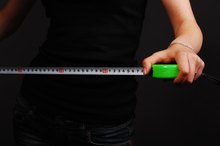What does fact checked mean?
At Healthfully, we strive to deliver objective content that is accurate and up-to-date. Our team periodically reviews articles in order to ensure content quality. The sources cited below consist of evidence from peer-reviewed journals, prominent medical organizations, academic associations, and government data.
The information contained on this site is for informational purposes only, and should not be used as a substitute for the advice of a professional health care provider. Please check with the appropriate physician regarding health questions and concerns. Although we strive to deliver accurate and up-to-date information, no guarantee to that effect is made.
What Is Normal Body Fat?
Body fat measurements provide an idea of how much fat you're carrying on your body in comparison to lean tissue, which includes muscle, bone, connective tissue and internal organs. Determining what's a "normal" body fat measurement depends on your definition. Normal may mean average, or it could mean a body fat for someone who's healthy and fit. Normal for an athlete is also different from normal for an average person.
About Body Fat
Body fat is often a better measure of health than your weight on the scale because a scale doesn't differentiate the type of mass it's weighing. You could be of normal weight, but have too much body fat, which puts you at a higher risk of chronic diseases such as heart disease and type 2 diabetes 4.
Body fat consists of essential fat and storage fat 4. The fat in your brain and the rest of your central nervous system, internal organs, intestines and bone marrow is essential fat, crucial to good health. In men, this essential fat is about 2 to 5 percent, while, for women, it's a higher 10 to 13 percent to allow for childbearing.
Keeping your body fat extremely low -- at your essential fat level or just a few percentages above it -- is extremely challenging to maintain and not normal; it's approximately the body fat level you see on bodybuilders during competition.
- Body fat is often a better measure of health than your weight on the scale because a scale doesn't differentiate the type of mass it's weighing.
- In men, this essential fat is about 2 to 5 percent, while, for women, it's a higher 10 to 13 percent to allow for childbearing.
Healthy Body Fat Guidelines
What Is Fat-Free Body Mass?
Learn More
A normal body fat range that's acceptable and not considered overweight is between 15 and 20 percent for a man and 24 and 30 percent for a woman. A man who regularly visits the gym and takes his fitness seriously might measure between 11 and 14 percent, while a fit woman is between 16 to 23 percent fat. A trained male athlete normally falls between 5 and 10 percent, while a female athlete falls between 8 and 15 percent.
Remember that these statistics are not absolute. Other organizations, such as the American Council on Exercise, have slightly different ranges 1. For example, they classify a man with a body fat percentage of 18 to 24 percent and a woman from 25 to 31 percent as average, but they don't specify whether those levels are healthy. Health organizations agree, though, that a body fat above 30 percent for a woman and 20 percent on a man puts them in the overweight category and at an increased health risk.
- A normal body fat range that's acceptable and not considered overweight is between 15 and 20 percent for a man and 24 and 30 percent for a woman.
- A man who regularly visits the gym and takes his fitness seriously might measure between 11 and 14 percent, while a fit woman is between 16 to 23 percent fat.
Body Fat and Aging
No official guidelines are established for healthy body fat levels for different age groups, but your body composition typically changes throughout adulthood. As you age past 20, you naturally gain 1 to 3 percent fat per decade up until age 60; you also lose about 2 percent bone mass as you age. These changes affect your body fat percentage so that when you're older, you might be at a very healthy body fat level, but in a slightly higher range than someone 20 years your junior.
- No official guidelines are established for healthy body fat levels for different age groups, but your body composition typically changes throughout adulthood.
- These changes affect your body fat percentage so that when you're older, you might be at a very healthy body fat level, but in a slightly higher range than someone 20 years your junior.
Evaluating Your Body Fat
Definition of Lean Body
Learn More
Among athletes, weightlifters, wrestlers, cross-country skiers, triathletes and gymnasts have some of the lowest body fat percentages. Football linemen, volleyball players, female basketball players and shot-putters have some of the higher body fat percentages. All are generally within a healthy range, however.
If you're curious about your body fat level, have it measured by a fitness professional using calipers or a high-tech body-fat analyzer. Home scales that use bioelectrical impedance can vary wildly according to your hydration levels. The most accurate measures, such as DEXA scans or hydrostatic weighing, must be done in a clinical setting and are often prohibitively expensive.
- Among athletes, weightlifters, wrestlers, cross-country skiers, triathletes and gymnasts have some of the lowest body fat percentages.
- Football linemen, volleyball players, female basketball players and shot-putters have some of the higher body fat percentages.
Related Articles
References
- American Council on Exercise: What Are the Guidelines for Percentage of Body Fat Lost?
- University of New Mexico: Understanding Body Composition
- Today's Dietitian: When Thin Is Fat
- Human Kinetics: Normal Ranges of Body Weight and Body Fat
- Lee SY, Gallagher D. Assessment methods in human body composition. Curr Opin Clin Nutr Metab Care. 2008;11(5):566-72. doi:10.1097/MCO.0b013e32830b5f23
- St-onge MP, Gallagher D. Body composition changes with aging: the cause or the result of alterations in metabolic rate and macronutrient oxidation?. Nutrition. 2010;26(2):152-5. doi:10.1016/j.nut.2009.07.004
- Clark JE. Erratum to: Diet, exercise or diet with exercise: comparing the effectiveness of treatment options for weight-loss and changes in fitness for adults (18-65 years old) who are overfat, or obese; systematic review and meta-analysis. J Diabetes Metab Disord. 2015;14:73. doi:10.1186/s40200-015-0154-1
- American Academy of Orthopaedic Surgeons. Female Athlete Triad: Problems Caused by Extreme Exercise and Dieting. http://orthoinfo.aaos.org/topic.cfm?topic=A00342.
- American Council on Exercise. Tools and Calculators. https://www.acefitness.org/acefit/healthy_living_tools_content.aspx?id=2
- Fahey TD. Fit & Well: Core Concepts and Labs in Physical Fitness and Wellness. New York: McGraw-Hill Education; 2017.
- National Heart, Lung, and Blood Institute. Assessing Your Weight and Health Risk. https://www.nhlbi.nih.gov/health/educational/lose_wt/risk.htm.
Writer Bio
Andrea Boldt has been in the fitness industry for more than 20 years. A personal trainer, run coach, group fitness instructor and master yoga teacher, she also holds certifications in holistic and fitness nutrition.









